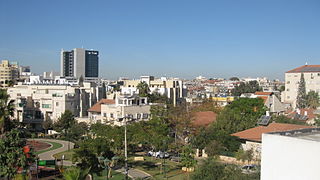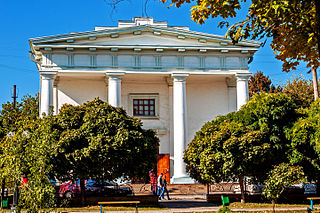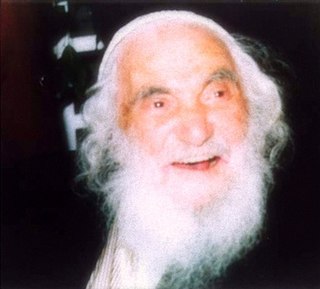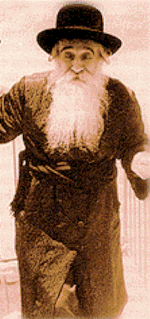Ger is a Polish Hasidic dynasty originating from the town of Góra Kalwaria, Poland, where it was founded by Yitzchak Meir Alter (1798–1866) known as the "Chiddushei HaRim". Ger is a branch of Peshischa Hasidism, as Yitzchak Meir Alter was a leading disciple of Simcha Bunim of Peshischa (1765–1827). Before the Holocaust, followers of Ger were estimated to number in excess of 100,000, making it the largest and most influential Hasidic group in Poland. Today, the movement is based in Jerusalem, and its membership is estimated at 11,859 families, most of whom live in Israel, making Ger the largest Hasidic dynasty in Israel. However, there are also well-established Ger communities in the United States and in Europe. In 2019, Shaul Alter and his followers split off from the dynasty, which was up to that moment led by his cousin Yaakov Aryeh Alter.

Breslov is a branch of Hasidic Judaism founded by Rebbe Nachman of Breslov (1772–1810), a great-grandson of the Baal Shem Tov, founder of Hasidism. Its adherents strive to develop an intense, joyous relationship with God, and receive guidance toward this goal from the teachings of Rebbe Nachman.

Nachman of Breslov, also known as Reb Nachman of Bratslav, Reb Nachman Breslover, Nachman from Uman, was the founder of the Breslov Hasidic movement.

Bnei Brak or Bene Beraq is a city located on the central Mediterranean coastal plain in Israel, just east of Tel Aviv. A center of Haredi Judaism, Bnei Brak covers an area of 709 hectares, and had a population of 204,639 in 2019. It is one of the poorest and most densely populated cities in Israel, and the 8th-most densely populated city in the world.

Belz is a Hasidic dynasty founded in the town of Belz in Western Ukraine, near the Polish border, historically the Crown of the Kingdom of Poland. The group was founded in the early 19th century by Rabbi Shalom Rokeach, also known as the Sar Shalom, and led by his son, Rabbi Yehoshua Rokeach, and grandson, Rabbi Yissachar Dov, and great-grandson, Rabbi Aharon, before the Nazi invasion of Poland in 1939. While Rabbi Aharon managed to escape Europe, most of the Belz Hasidim were killed. Rabbi Aharon re-established the Hasidut in Tel Aviv, Israel. Today, Belz is one of the largest Hasidic groups in Israel, and has sizable communities in Belgium, New York, New Jersey, Canada, and Australia.

Uman is a city located in Cherkasy Oblast (province) in central Ukraine, to the east of Vinnytsia. Located in the historical region of the eastern Podolia, the city rests on the banks of the Umanka River at around 48°45′N30°13′E. Uman serves as the administrative center of Uman Raion (district). It hosts the administration of Uman urban hromada, one of the hromadas of Ukraine. Population: 82,154

Na Nach Nachma Nachman Me'uman is a Hebrew language name and song used by a subgroup of Breslover Hasidim colloquially known as the Na Nachs. It is a kabbalistic formula based on the four Hebrew letters of the name Nachman, referring to the founder of the Breslov movement, Rebbe Nachman of Breslov, along with a reference to his burial place in Uman, Ukraine.

Rabbi Yisroel Dov Ber Odesser, also known as Reb Odesser or Sabba, was a Breslover Hasid and rabbi who claimed to have received a "Letter From Heaven" sent directly to him by Rebbe Nachman of Breslov, who had died 112 years earlier, revealing to him a new remedy for relieving the world's suffering and illness. This remedy is the song and name Na Nach Nachma Nachman Meuman, which he revealed in his old age to newfound followers throughout Israel. His following developed into the Na Nach movement. Some controversies surround the origin of the Letter, Rabbi Odesser's bold claims regarding Na Nach Nachma Nachman Meuman, and his position in the Breslov movement.
Rabbi Yisroel Halpern, also known as Yisroel Karduner, was a Breslover Hasid who lived in Ottoman Palestine at the turn of the century.
Yitzchok Breiter (1886-1943?) was a Breslover Hasidic rabbi who spread the teachings of Rebbe Nachman of Breslov beyond their origins in Ukraine to the country of Poland during the 1920s to 1930s.

Ohel is a structure built around a Jewish grave as a sign of prominence of the deceased. Ohelim cover the graves of some Hasidic Rebbes, important rabbis, tzadikim, prominent Jewish community leaders, and biblical figures. Typically a small masonry building, an ohel may include room for visitors to pray, meditate, and light candles in honor of the deceased.

Har HaMenuchot is the largest cemetery in Jerusalem. The hilltop burial ground lies at the western edge of the city adjacent to the neighborhood of Givat Shaul, with commanding views of Mevaseret Zion to the north, Motza to the west, and Har Nof to the south. Opened in 1951 on 300 dunams of land, it has continually expanded into new sections on the northern and western slopes of the hill. As of 2008, the cemetery encompasses 580 dunams in which over 150,000 people are buried.

Husiatyn is the name of a Hasidic dynasty, whose founder was a scion of the Ruzhiner dynasty. Husiatyn is located in present-day Ukraine.
Reuvein Margolies, was an Israeli author, Talmudic scholar and head of the Rambam library.

The Tel Aviv transportation system is seen as the hub of the Israeli transport network in terms of road, rail, and air transport. The Israeli road network partly centers on the city, with some of the country's largest highways passing through or running to the city. The city forms a major part of the country's rail network, whilst Ben Gurion International Airport located near the city is the country's largest airport. There is also a strong public transport system within the city, based primarily on bus transportation.

Mordechai Shlomo Friedman, sometimes called Solomon Mordecai Friedman, was the Boyaner Rebbe of New York for over 40 years. In 1927 he left Europe to become one of the first Hasidic Rebbes in America, establishing his court on the Lower East Side of New York City and attracting many American Jewish youth with his charismatic and warm personality. He also played a role in American Jewish leadership with positions on Agudath Israel of America, the Moetzes Gedolei HaTorah, and Holocaust rescue organizations. In 1957 he built the flagship Ruzhiner yeshiva, Tiferet Yisroel, at the top of Malkhei Yisrael Street in Jerusalem.
Zvi Malnovitzer is an expressionist painter born to a Haredi, or ultra-Orthodox, religious family in Bnei Brak, Israel. His upbringing in a society isolated from the modern world, where he was dedicated to intensive and uninterrupted Talmudic study from a young age, makes his decision to become an artist unusual, bold, and one of accomplishment. During his training in Reichenau, Austria, where he studied under the auspices of artist Wolfgang Manner and under the direction of Ernst Fuchs, Malnvotizer developed a unique style portraying themes that straddle the religious and secular worlds.

Shikun Chabad, also spelled Shikun Habad, is a Hasidic Jewish neighborhood in northern Jerusalem. It includes the oldest Hasidic yeshiva in Israel and Jerusalem, Yeshivas Toras Emes.

Yehoshua Mondshine (1947–2014) was an Israeli rabbi, scholar, researcher and historian associated with the Chabad-Lubavitch, Hasidic movement. Mondshine worked as a librarian and bibliographer at the National Library of Israel in Jerusalem.
Shai Azoulay is an Israeli painter. Azoulay lives and works in Jerusalem and is a faculty member of the Fine Art Department of The Bezalel Academy of Arts and Design.















